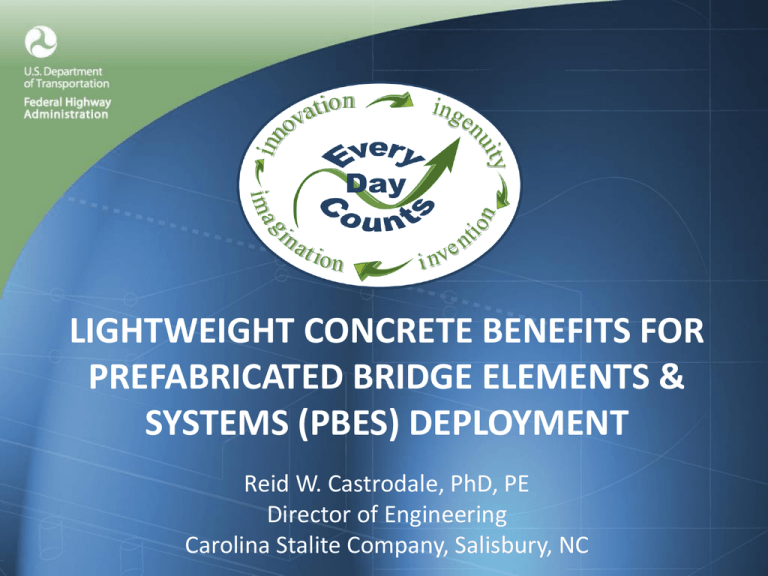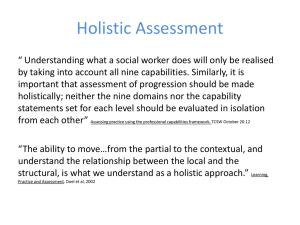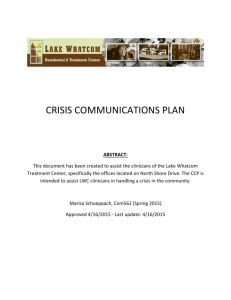Accelerating Bridge Construction with Prefabricated Bridge
advertisement

LIGHTWEIGHT CONCRETE BENEFITS FOR PREFABRICATED BRIDGE ELEMENTS & SYSTEMS (PBES) DEPLOYMENT Reid W. Castrodale, PhD, PE Director of Engineering Carolina Stalite Company, Salisbury, NC Development of LWC • In early 1900s, Stephen Hayde discovered method to manufacture lightweight aggregates (LWA) from shale, clay and slate – Some bricks bloated during burning – Development of rotary kiln process began in 1908 – Patent for expanding LWA using a rotary kiln process was granted in 1918 • The first use of lightweight concrete (LWC) was for ships in World War I Development of LWC • Early use of LWC in a bridge project – San Francisco-Oakland Bay Bridge – Upper deck of suspension spans was constructed using LWC in 1936 – Lower deck was rebuilt with LWC for highway traffic in 1958 – Both decks are still in service Structural LWA • LWA is manufactured – Raw material is shale, clay or slate – Expands in kiln at 1900 – 2200 deg. F – Gas bubbles formed in softened material are trapped when cooled 4 Relative Density • Rotary kiln expanded LWA – Range from 1.3 to 1.6 • Normal weight aggregate – Range from 2.6 to 3.0 • Twice the volume for same mass • Half the mass for the same volume 1 lb. of each aggregate LWA is just a lighter rock! • LWA should satisfy NWA specifications – Except different gradations – AASHTO M 195 • LWA has higher absorption than NWA – Needs to be prewet, especially for pumping • For LWC – Same batch plants and mixing procedures – Same admixtures – Can use same mix design procedures – “Roll-o-meter” for measuring air content Lightweight Concrete LWA is used to reduce the density of concrete • “All lightweight” – all aggregates, both Most fine and coarse, are lightweight common • “Sand lightweight” – lightweight coarse aggregate and normal weight sand • “Specified density” – blend of NW and LW aggregate to achieve target density (SDC) • Density of LWC is specified, so it must be measured during placement for QC Definitions • AASHTO LRFD Specs (Section 5.2) – Lightweight concrete: "Concrete containing lightweight aggregate and having an air-dry unit weight not exceeding 0.120 kcf …" – Normal weight concrete: “Concrete having a weight between 0.135 and 0.155 kcf” • Concrete that falls between these definitions is often called specified density concrete (SDC) Spectrum of Concrete Density All LWC Sand LWC SDC NWC SDC 90 - 105 pcf 110 - 125 pcf 135 - 155 pcf LW Fine NW Fine NW Fine LW Coarse LW Coarse NW Coarse Density ranges shown are approximate Must add allowance for reinforcement (typ. 5 pcf) Specifying Density of LWC • “Equilibrium density” is defined in ASTM C 567 – Density after moisture loss has occurred – Often used for dead load calculations • “Fresh density” used for QC tests during casting – Use for handling loads at early age – Suggest using for final design loads in large elements • Add reinforcement allowance to concrete density when computing dead loads (typ. 5 pcf) DOT Specifications for LWC Sand LWC for Bridge Decks • TennDOT includes in Standard Specifications • NCDOT, UDOT, etc. have std special provisions • VDOT & other states have proj. special provisions All LWC • Has not been used in recent years • Special provisions are being developed for NCDOT DOT Specifications for LWC Semi-LWC for Girders • INDOT allows in design manual (120-130 pcf) – Recurring special provisions being developed Sand LWC for Girders • GDOT has special provisions (10 ksi at 120 pcf) • VDOT has special provisions (8 ksi at 125 pcf) Approved aggregate lists • A number of states have approved LWA sources GDOT Special Provisions • Special provisions for 10 ksi LW HPC girders – Maximum air-dry density is 120 pcf – Size of LW coarse aggregate = ½ in. – Minimum cement factor = 650 lbs/cy – Maximum water-cement ratio = 0.330 – Slump acceptance limits = 4½ ± 2½ in. – Entrained air acceptance limit = 5 ± 1½ % – Max. chloride permeability = 3,000 coulombs • Same as for NW HPC, except density & aggr. size Benefits of LWC • Reduced weight of precast elements – Affects handling, shipping and erection – Can also improve structural efficiency • Enhanced durability – Reduced cracking tendency Opposite of what many expect! – Reduced permeability – Tighter quality control with a specified density Focus for this presentation – Reduced weight for PBES deployment Cost of LWC • Increased cost of LWA – Additional processing – Shipping from the manufacturing plant Cost Premium for LWC • Effect of sand LWC on cost of bridge LWC Premium / CY Cost / SF $20 / CY $0.56 / SF $30 / CY $0.83 / SF $40 / CY $1.11 / SF – Cost / SF assumes 9 in. thick deck (average) – Premium depends on cost of LWA, cost of NWA being replaced, and shipping cost Sample Girder Cost Analysis • Cost premium for LWC for Mod BT-74 girder – Assume $30 / CY = $6.83 / LF – Cost premium for LWC for 150 ft girder = $1,024 • Cost reduction by using LWC – Shipping from plant to site = $811 • NWC girder = 69 t; LWC girder = 58 t, or 11 t less – Drop 4 strands / girder @ $0.65 / LF ea. = – Total cost reduction = • Net savings by using LWC $390 $1,201 $177 PBES Applications for LWC • Sand LWC & Specified Density Concrete – Use for any precast or prestressed conc. elements • All LWC – Can be used for any precast concrete element – Data not yet available for prestressed elements All LWC Sand LWC SDC NWC 105 pcf 120 pcf 135 pcf 145 pcf These are fresh densities for concrete up to about 6 ksi Add 5 pcf allowance for reinforcement Impact of LWC on PBES • Consider sample projects – Precast foundation elements – Precast pile & pier caps – Precast columns – Precast full-depth deck slabs – Cored slabs & Box beams – NEXT beams & Deck girders – Full-span bridge replacement units with precast deck – Bridges installed with SPMTs Mill Street Bridge, NH • Precast foundation elements – Project did not use LWC • Comparison for abutment footings – Abutment walls have similar weights % Weight Weight Chng. Chng. Chng. as Des. as Built 150 pcf 0 39 t 0 25 t 0 125 pcf 17% 32 t 7t 20 t 5t 110 pcf 27% 28 t 11 t 18 t 7t Okracoke Island, NC • Precast pile caps – Project did not use LWC • End bent pile cap – 2 pieces – Size: 21 ft long x 3.67 ft x 3 ft – 3 pile pockets per piece Pile Cap Weight Chng. % Chng. 150 pcf 16 t 0 0 125 pcf 13 t 3t 17% 110pcf 12 t 4t 27% Lake Ray Hubbard, TX • Precast pier caps – Project did not use LWC • Typical pier cap on 3 columns – Size: 37.5 ft long x 3.25 ft x 3.25 ft Pier Cap Weight Chng. % Chng. 150 pcf 29 t 0 0 125 pcf 24 t 5t 17% 110 pcf 21 t 8t 27% Edison Bridges, FL • Project did not use LWC • Precast columns – Max wt = 45 tons @ 150 pcf – Max wt = 37 tons @ 125 pcf • Precast caps – Using 128 pcf SDC could have eliminated pedestal for tall columns – Max wt = 78 tons @ 150 pcf – Max wt = 65 tons @ 125 pcf Woodrow Wilson Br, VA/DC/MD • Deck replacement with full-depth precast deck panels in 1983 • Sand LWC was used for panels – Allowed thicker deck – Allowed widened roadway with no super- or substructure strengthening – Reduced shipping costs and erection loads • LWC deck performed well until bridge was recently replaced to improve traffic capacity Okracoke Island, NC • Precast cored slabs – Project did not use LWC • 21” deep by 3 ft wide – 30 and 50 ft spans Ext. 50 ft span Weight Chng. % Chng. 150 pcf 16.0 t 0 0 125 pcf 13 t 3t 17% 125 pcf - Solid 16.4 t 0.4 t +3% Okracoke Island, NC • Precast barriers – Project was not designed with LWC • Contractor proposed casting barriers on cored slabs in precast plant – Sand LWC was used for the barrier Barrier Weight Chng. % Chng. 150 pcf 13.7 t 0 0 125 pcf 11.4 t 2.3 t 17% 110 pcf 10.1 t 3.6 t 27% Mill Street Bridge, NH • Precast box beams – Project did not use LWC • NWC box beam weight governed crane size with 2 crane pick Ext. Box Beam Weight Chng. % Chng. 150 pcf 69 t 0 0 125 pcf 57 t 12 t 17% – Using LWC for box beam would make beam pick nearly equal to NWC substructure elements NEXT F Beams • Compare section weights for NEXT 36 F – NWC @ 155 pcf; Sand LWC @ 130 pcf – No max. span NEXT 36 F charts for sand LWC 1700 1592 – 16% reduction in weight for same width sections – 12 ft wide LWC is lighter than 8 ft wide NWC Weight per Foot (lbs) 1600 1489 1500 1400 16% 1385 1335 1300 1249 1200 1162 1100 8 ft 10 ft 12 ft 8 ft 10 ft 1000 NWC LWC 12 ft NEXT D Beams • Compare section weights for NEXT 36 D – 12 ft width not used to limit weight of NWC section – Max. span charts NEXT 36 F are provided for sand LWC 2200 2100 2000 – 16% reduction in weight for same width sections – 12 ft LWC is lighter than ft NWC Weight per Foot (lbs) 2000 1900 1800 16% 1851 1793 1677 1700 1600 1504 1500 8 ft 10 ft 12 ft 8 ft 10 ft 1400 NWC LWC 10 12 ft Deck Girders, NY • Precast deck girder – Project did not use LWC • 41” deep deck girders with 5 ft top flange – 87.4 ft long girders Girder & Deck Weight Chng. % Chng. 158 pcf 45 t 0 0 130 pcf 37 t 8t 18% NWC density was obtained from girder fabricator Specified concrete compressive strength = 10,000 psi I-95 in Richmond, VA • Prefabricated full-span units – Steel girders and sand LWC deck • Maximum precast unit weight for current project Deck Weight Chng. % Chng. 145 pcf 132 t 0 0 120 pcf 116 t 16 t 12% 105 pcf 106 t 26 t 20% Deck densities do not include reinforcement allowance Lewis & Clark Bridge, OR/WA • Deck replacement on existing truss – Sand LWC precast deck units with steel floor beams – Sand LWC density = 119 pcf – Max. deck unit weight = 92 t ¢ STRINGER 0.02'/FT. 17'-1" ¢ STRINGER 3'-0" (TYP.) 7" 1¼" MMC OVERLAY – LWC saved about 14 t 5'-6" (TYP.) 0.02'/FT. • Existing deck was LWC **Note – New panel weighs about 5% less than original** – Was in service 73 years 2" 9" Bridges set with SPMTs, UT • 3300 South over I-215 – Built in 2008 – Sand LWC used for deck – Less deck cracking than bridges with NWC decks • 3 bridges to be moved in 2011 – Steel girder bridges with sand LWC decks – 200 South over I-15 – 2 spans @ 3.1 million lbs – Sam White Lane over I-15 – 2 spans @ 3.8 million lbs – I-15 Southbound over Provo Center Street –2 moves of 1.5 and 1.4 million lbs Graves Ave. over I-4, FL • Complete span replaced using SPMTs – Project did not use LWC • Comparison of weight for NWC and sand LWC – Appendix C in FHWA “Manual on Use of SPMTs …” Girder Deck Weight Chng. % Chng. 152 pcf 150 pcf 1,282 t 0 0 127 pcf 120 pcf 1,049 t 233 t 18% 127 pcf 105 pcf 996 t 286 t 22% Comparison with ALWC deck is not in Manual Questions? For more information on LWA and LWC • Contact Reid Castrodale: rcastrodale@stalite.com • Visit the Expanded Shale, Clay and Slate Institute website: www.escsi.org • Contact local LWA suppliers: listed on ESCSI website








